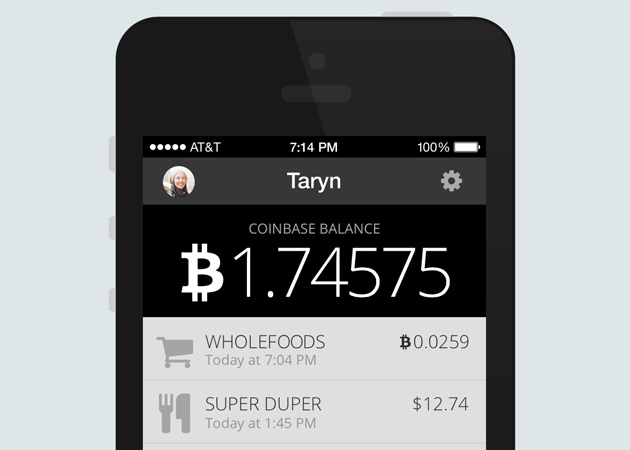The reversible USB Type-C standard has now been finalized, which should save the world untold man-hours in mis-plugging. Roughly the size of a current micro-USB Type-B connector, it uses matching rows of contacts on the top and bottom so that you can shove it in either way around. Type-C is a version of the 10Gbps USB 3.1 standard (twice as fast as USB 3.0), but slimmed down for compact and mobile devices. It'll also support the USB Power Delivery spec to carry up to 100 watts, easily enough to power a laptop. Unfortunately, the new connector isn't compatible with the current USB standard, except via converters. While there are no devices with USB 3.1 yet, it'll likely be standardized on most future laptops and mobile devices -- unlike its pricey rival, Thunderbolt.
Part of the challenge of Bitcoin and other virtual currencies has simply been the need to juggle different apps and cards to use every payment option at your disposal. Wouldn't it be nice if one card could handle everything? You might just get your wish. Shift Payments is testing a new debit card that can switch between real and virtual money on the spot, such as through an app; you could pay for morning coffee with Bitcoin and after-work groceries using real cash. Loyalty card support is in the works, too.
Samsung's finally launched the much-leaked Galaxy Alpha, a fancier-looking but stripped-down version of the Galaxy S5. As expected, it sports a substantially different, less rounded design than the GS5, with metal sides that gives it a glancing resemblance to an iPhone 5s. The Alpha is also much lighter and thinner than its big brother at a mere 6.7mm and 115 grams. Samsung said it took a "fresh approach" with the new handset's looks, something it vowed to do in the face of a steep downturn in sales. The new design could also give some clues about the look of the Galaxy Note 4, set to launch early next month.
In case there was any doubt that KitKat now has a solid foothold in the Android world, Google just offered some proof. Its usage data for early August shows that KitKat is on more than a fifth of active Android devices, at 20.9 percent. That's a healthy improvement over July (17.9 percent), and a big leap over the 14.9 percent we saw in June. The folks in Mountain View aren't explaining the steady growth, but it's easy to figure out what's going on -- big-name devices like the LG G3 and Samsung Galaxy Tab S are bringing this latest OS flavor to a wider audience, and many older gadgets are still getting upgrades.
After eight months of beta testing, the Opera Max web compression app is finally getting a launch partner, and it happens to be in Vietnam. Opera's joining forces with local carrier Mobiistar to have the app preloaded on select Android devices (Lai504m, Bean414 and Prime508). By way of multimedia content plus text compression, the service claims to save up to 50 percent of data bandwidth -- it's all visualized in the app for your viewing pleasure. For those outside of Vietnam, you can still install the beta app and try it out in the US, Europe, Brazil and Russia; or try the customized version of Opera Max if you're in China.
HTC's been making Android skins and apps for a long time, but now the company wants its home-grown software to conquer more devices -- even those made by other manufacturers. According to Recode, the Taiwanese phonemaker has started developing apps for Android phones in general, courtesy of a new business unit called HTC Creative Labs. The Creative Labs team's first product is called Zoe (originally available on the One M7), which has the power to stitch together up to 16 videos or images. You merely need to select a theme along with the images/videos, as well as a soundtrack, and it can automatically create a highlight reel.

The ability to turn iPhones into remote controls is something Peel has done before, but this time out it's doing things slightly different. With its new iOS app, Peel now lets you use your iPhone, iPod touch and/or iPad as a smart remote for Dish Network and DirecTV boxes, without the need for additional hardware -- which was the case with the Fruit, a $99 peripheral the startup introduced about three years ago. Peel's iOS application isn't just a remote, however; it also comes with discovery features that bring you personalized recommendations on stuff you should watch. In addition to that, Peel acts as a TV guide too, allowing you to easily find shows or movies even if you're not a Dish or DirecTV subscriber. Peel Smart Remote and TV Guide is compatible with the Dish Hopper and Hopper with Sling (excluding some models), as well as any WiFi-equipped DirecTV box.

Just when you think the Chromecast can't get any better, it does. So, with more and more services offering support for the diminutive (and very cheap) device, it's only natural for Google to make its own apps work better with it. To that end, Google+ on Android now lets you display photos from your social stream on a nearby television, thanks to a newly added button in the search giant's networking application. Technically, doing that was already (sort of) possible with Android's screen mirroring on Chromecast, but this is something actually designed to be viewed on a TV. Once it starts casting, the Google+ app can cycle through posts from your feed and put them in a loop -- that said, you also have the option to pause, in case there's a photo you really like and want to use as a wallpaper of sorts. Right now, the feature appears to be limited to Android, though it wouldn't surprise us to see it come to the iOS version of the app later on.
Sure, you've seen a 3D render of Samsung's widely leaked virtual reality headset, but what's it like in the real world? Well, you may be looking at it right now -- The Verge has posted what it says is a photo of the Oculus-backed eyewear. It's not quite as sleek as the earlier imagery, but the basic formula lines up with what we've heard; a faceplate at the front lets you plug your phone in and use it as a screen for VR games and other apps. The biggest change from the early image is the presence of a focus dial that helps you see clearly. There's no certainty that this is exactly what Samsung will unveil at next month's IFA show, assuming it's authentic in the first place, but it wouldn't surprise us in the least to see this wearable display on stage.
NVIDIA set out to claim the Android performance crown when it unveiled its 64-bit Tegra K1 processor at the start of the year, and it's now ready to explain why it expects to come out on top. The chip's two Project Denver cores will have an edge partly because they'll optimize code on the fly -- they'll break down big instructions into tiny, super-efficient functions that can be recycled as often as necessary. The company expects roughly twice the speed it would get from ordinary code, making the 64-bit K1 faster than you'd expect just by looking at the hardware. It should tout "significantly higher" performance than current four- and eight-core mobile CPUs, and run as well as some PC processors; be prepared for more Tegra-powered laptops and high-end tablets.
Ever since the original Moto RAZR V3 came out 10 years ago, the smartphone industry has had a strange obsession with skinny phones. Not because shaving a millimeter or two off a device will give it more functionality, but because it's an effective marketing tactic. In emerging markets in particular, slimmer phones at slimmer prices enjoy a distinct advantage. Gionee, a handset maker based in China, isn't very well known, but it's looking to make a name for itself with devices like the $375 Elife S5.5. At 5.55mm thick, this svelte beauty currently claims the title for the thinnest smartphone on the market. To put that in perspective, that's a full two millimeters skinnier than the iPhone 5s. I spent a few days with the device to see if thinner really is better.
When you're looking to celebrate a milestone for your company's forums, what's the best way to do so? How about a sexist photo contest where the entrant that nabs the most likes gets a the chance to buy a phone? Sounds like a terrible idea. Well, that's just what OnePlus did to commemorate 200K registered message board users. In order to be eligible, ladies (no boys allowed) had to draw the outfit's logo on a piece of paper or on their body, take a picture of themselves and post it in the contest thread. The top 50 "most well-liked" women would earn a t-shirt, and if there were at least 500 entries, OnePlus promised an invite to purchase it's One smartphones to "our favorite photo." So yes, the winner still had to pay for the device they "won." As you might've guessed, folks around the internet expressed their rage almost immediately and links to the contest thread are dead several hours later. We've reached out to see if the promotion has officially been pulled and what OnePlus has to say about it, but it looks like the masses have prevailed.
Update: OnePlus has provided a statement in response to our query, and is apologetic about a "misguided" effort to reach out to women. The company says it's "thrilled to have a small but growing number of women active in our online community," and deeply regrets any offense caused. You can read the statement in full after the break.
We've still got a little under a month left before Destiny officially makes its way to consoles, but we already know a bit about Bungie's expansion plans. At a Sony Gamescom event, the company announced that its first expansion pack for multiplayer, The Dark Below, will be available to everyone this December. Of course, it wouldn't be a Sony-related event without some exclusive content, and Bungie didn't disappoint there: The new expansion will come with a map called Blue Exodus that's exclusive to PlayStation 4 users.
Verizon has largely finished rolling out its LTE network, but that only raises a new question: when is it going to phase out its long-running CDMA phone service? As it turns out, the transition may start sooner than you think. The carrier's Fran Shammo has revealed at an investor conference that the first phones to rely solely on LTE for calls will be available in the first half of 2016, or just under two years after the launch of LTE voice service in late 2014. He didn't say when Big Red would turn the lights out on CDMA, but it's safe to presume that this won't happen until the majority of devices in use can handle the newer technology. In short, you shouldn't worry about buying a Verizon phone today -- just don't expect to keep it for several years.
[Image credit: AP Photo/John Minchillo]

Family mobile plans might be big in the US, but they haven't really got going in the UK. However, that isn't stopping Vodafone from trying to change people's minds with the launch of its new Red+ plan. Instead of equipping a family with individual tariffs, Vodafone aims to supply each member of the household with their own SIM, allowing the "plan leader" to distribute monthly data limits depending on how data thirsty they are. These so-called leader plans are basically upgraded Red plans that come with a 2GB, 4GB, 7GB, 10GB or 13GB data allowance, which can then be shared with a family member in 500MB, 1GB, 2GB or 4GB amounts.











